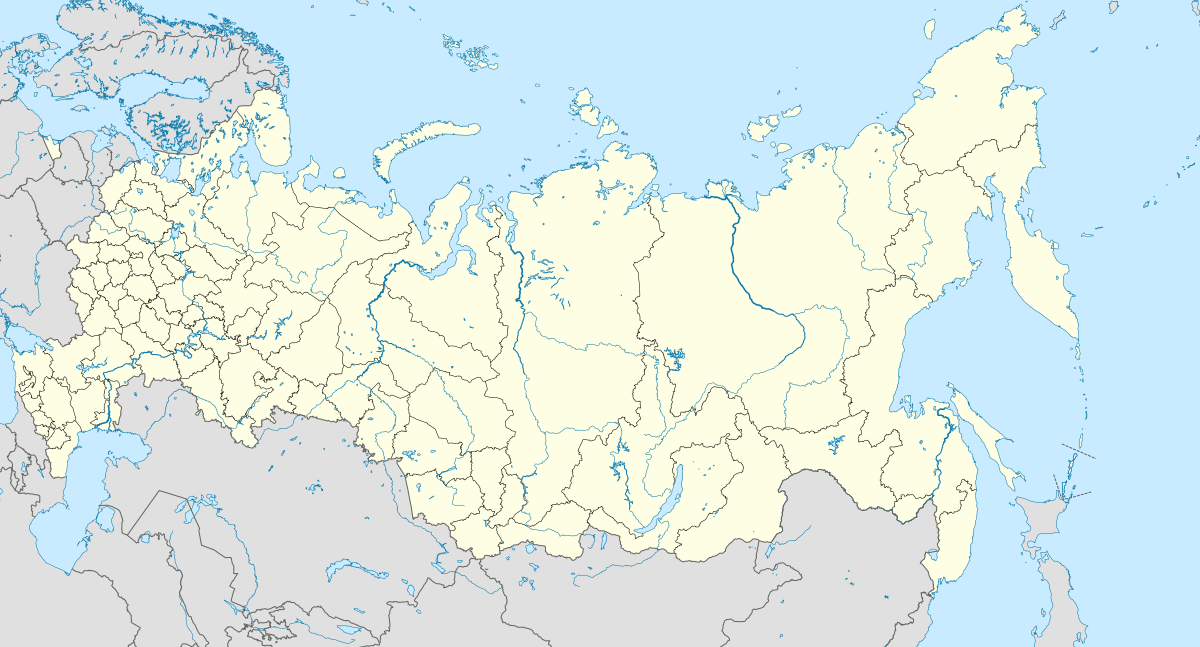Olenegorsk Radar Station
Olenegorsk Radar Station (also described as Olenegorsk-1 (Russian: Оленегорск-1) or Murmansk) is the site of a Soviet and Russian early warning radar. It is located near Olenegorsk on the Kola Peninsula, north of the Arctic Circle in north west Russia. It is considered to be a key part of the Russian early warning system against ballistic missile attack, and provides coverage of ballistic missile launches in the Norwegian Sea and North Sea. The station is operated by the Russian Aerospace Defence Forces.
| Olenegorsk Radar Station | |
|---|---|
Оленегорск РЛС | |
| Murmansk, NW Russia | |
 An image of the site from landsat. The Dnepr is the wide 'V' shaped building, and the Daugava is the block to the north east. | |
 Olenegorsk Radar Station | |
| Coordinates | 68.1141°N 33.9102°E |
| Type | Radar Station |
| Code | RO-1 |
| Site information | |
| Open to the public | no |
| Condition | operational |
| Site history | |
| Built | 1963–[1] |
| Built by | Soviet Union |
| Garrison information | |
| Garrison | 57th Independent Radio-Technical Unit [1] |
The military town for the station is called Olenegorsk-1 and is at the village of Protoki (Russian: Протоки).[2] The station is 19 kilometres (12 mi) east of Olenya airbase and 27 kilometres (17 mi) east of Olenegorsk. 6 kilometres (3.7 mi) to the south east there was a military tropospheric scatter radio relay station.[2]
Radar
Olenegorsk was the site of one of the first two early warning radars in the Soviet Union, the other being at Skrunda-1.[3] The Dnestr-M radar (NATO codename: "Hen House") was started in 1963 and completed in 1969, entering service in 1971.[4]
A Daugava radar (NATO codename:"Pechora") was later built next to it.[5][6] This is a prototype Daryal receiver, a phased array receiver which worked with the Dnestr acting as a transmitter. The Daugava, which is still operational, was implemented in Olenegorsk to minimise interference caused by the Northern Lights.[4]
Voronezh
It is planned to replace the Dnestr-M/Daugava radars at Olenegorsk with the new generation of Russian early warning radar systems, the Voronezh radar. According to news reports a new Voronezh radar will start construction in 2017, replacing both existing radars.[7]
References
- Holm, Michael (2011). "57th independent Radio-Technical Unit". Soviet Armed Forces 1945–1991. Retrieved 2012-04-08.
- ТРОПОСФЕРНАЯ РАДИОРЕЛЕЙНАЯ СТАНЦИЯ 3/3500 [Tropospheric Radio Relay Stations 3/3500] (in Russian). 2011. Retrieved 2012-04-09.
- Podvig, Pavel (2002). "History and the Current Status of the Russian Early-Warning System" (PDF). Science and Global Security. 10: 21–60. CiteSeerX 10.1.1.692.6127. doi:10.1080/08929880212328. ISSN 0892-9882. Archived from the original (PDF) on 2012-03-15.
- Karpenko, A (1999). "ABM AND SPACE DEFENSE". Nevsky Bastion. 4: 2–47.
- Shko (2008). СПРН [SPRN (early warning)] (in Russian). Archived from the original on 2013-10-06. Retrieved 2012-01-08.
- SityShooter (2011). "РЛС "Днестр" – "Днепр-М" (actually is Daugava left)" [Radar Dnestr-Dnepr-M] (in Russian). Archived from the original on 2012-12-02. Retrieved 2012-01-29.
- Модернизация радаров СПРН в Северо-Западном округе начнется в 2015 году [Upgrading early warning radars in the Northwest District will begin in 2015] (in Russian). Lenta.ru. 2011-12-12. Retrieved 2012-01-09.